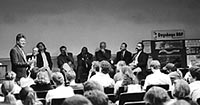

Although seldom visited by students, Lake Erie is a dominant part of Ohio. Part of the largest system of lakes in the world, it lies just 20 minutes from Oberlin.
Unfortunately, Ohio allowed pollution to build up in Lake Erie and the tributaries leading into it for decades.

The defense of our water is being led by the Water Quality Board, a joint advisory board between America and Canada. Six members of the board came to Oberlin Wednesday night to discuss the state of our rivers and lakes with Oberlin students.
Over 60 students and community members attended the forum. It began with an introduction by George Espy, director of Seventh Generation, a local environmental group. He said that there are 41 "problem spots" in the Great Lakes area, one of which is the Black River, which runs through Lorain County.
Don Schregardus, director of the Ohio EPA, gave the audience an overview of the Great Lakes. "Our Great Lakes are really a resource that's unparalleled in the world. We're looking at what needs to be done to improve the water quality of our Great Lake: Lake Erie," he said.
Schregardus continued, "We felt it was of vital importance to have the community involved, along with government." Thus the forum consisted mainly of conversation between community members and Water Quality Board members. It ranged from land use concerns in the Great Lakes region to more specific question about the Black River, all focused on water pollution prevention.
Point source versus non-point source pollution was clarified by the board. Point source pollution is generally emitted from factories and other specific locations. Non-point source pollution is primarily rural and urban runoff and thus harder to trace.
Non-point source pollution counts for at least 30 percent of all pollution. Much of it can be traced to agricultural runoff. One technique in the reduction of agricultural runoff is the promotion of conservation tillage. Peter Wise, board member and associate director of the Illinois EPA, said that over 80 percent of Illinois farmland is under conservation tillage.
The audience's questions included issues of urban sprawl and land use. Urban sprawl is a major contributor to contamination of watersheds, but funding for them is often sparse. Board member Craig Mather, Chief Administration Officer of Metro Toronto, said transportation planning is a prime controller of urban sprawl. "My municipality's funding has been cut 30 to 40 percent," he said.
According to board members, over 90 percent of some pollutants, such as mercury and PCPs, come from the air, making them more difficult to trace.
The Water Quality Board was formed by a landmark 1972 treaty on water quality. It is a unique joint advisory board which monitors the Great Lakes area. The six board members are holding meetings all over Lorain County in the next few days to discuss pollution issues related to the Black River watershed.
Great meeting: Members of the Water Quality Board answer questions about water pollution in the Great Lakes and the Black River watershed. (photo by Pauline Shapiro)
Copyright © 1998, The Oberlin Review.
Volume 127, Number 6, October 9, 1998
Contact us with your comments and suggestions.